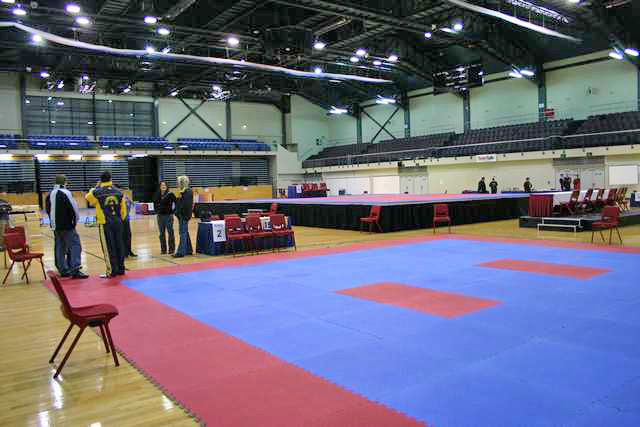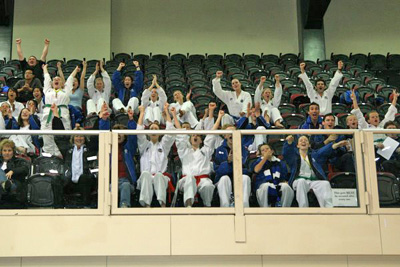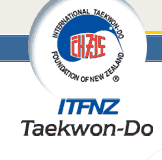ITFNZ
National Tournament 2006
Tae Kwon-Do scores the biggest win of all.
Michael Hoy, 1 Gup.
Wellington is a windy and cold place, a home of politicians, businesspeople and
students, a city accustomed to traffic, nightlife and the odd concert or sporting
event. It was to this place that 335 dobok-clad competitors and their supporters
flocked on the weekend of the 7th and 8th of October for the 2006 ITFNZ Nationals
Tournament; a tournament that many hold to be the most impressive yet, and one
that would have a more climactic and more dramatic conclusion than any could
have predicted. The question on my mind at first, however, was what did Wellington
think about this many people in one place, all wearing such a funny costume?
 Our venue was the Queens Wharf Events Centre on the Wellington waterfront, where
a small army was assembled on Friday night for weigh-in. I watched my team-mates
around me for first impressions of the competition arena; the general response
was 'Ooooooooo...'. Before us lay an expanse of polished wooden floor, with judging
tables arranged around five sparring rings. The centre ring was raised a metre
from the floor on a black stage, making an epic display for black belt events
- every competitor I spoke to had an independent vision of what would happen
if someone fell off the stage in the middle of a fight. Before the stage was
a VIP table covered with burgundy cloth. Down the northern wall there was a series
of breaking machines and a pile of wooden boards, ready to be reduced to kindling.
At the far end was a carpeted area reserved for warming up, which was being tested
out by several people in heavy jackets and beanies running shuttle lengths -
not willing to shave their head or cut their arm off they were doing what they
could to sweat out any excess weight. Our venue was the Queens Wharf Events Centre on the Wellington waterfront, where
a small army was assembled on Friday night for weigh-in. I watched my team-mates
around me for first impressions of the competition arena; the general response
was 'Ooooooooo...'. Before us lay an expanse of polished wooden floor, with judging
tables arranged around five sparring rings. The centre ring was raised a metre
from the floor on a black stage, making an epic display for black belt events
- every competitor I spoke to had an independent vision of what would happen
if someone fell off the stage in the middle of a fight. Before the stage was
a VIP table covered with burgundy cloth. Down the northern wall there was a series
of breaking machines and a pile of wooden boards, ready to be reduced to kindling.
At the far end was a carpeted area reserved for warming up, which was being tested
out by several people in heavy jackets and beanies running shuttle lengths -
not willing to shave their head or cut their arm off they were doing what they
could to sweat out any excess weight.
The tournament atmosphere the next day was a maelstrom
of light and sound. Regional teams, dressed in colourful
tracksuit uniforms, clustered in their marked areas on
the raised seats overlooking the five rings and the marshalling
area. Periodically each team would break into a somewhat
coordinated chant, sometimes in lyrical verse displaying
impressive originality, sometime in an uncoordinated baying
that would reduce to a cheerful but droning repetition
of their team name. With five events underway at any one
time it was often difficult to say exactly who was cheering
for what: somewhere in the distance a hand goes up in the
air, and a surging wave of yelling indicates that it was
one of our guys. Occasionally an MC would announce an event
over a loudspeaker, drumming up support for one of the
champions from one region or another and pulling all eyes
in on the centre ring. Other times a particularly popular
fighter would be on in one of the corner rings, and their
teams would cluster around the seats above in a poorly
colour-coordinated crowd, making a din so loud the fighters
have trouble hearing the commands of their referee. The
view of a fight from above was fantastic; no strike was
obscured, no impact couldn't be felt vicariously and no
pained facial expression was hidden - to a chorus of groans
from the unlucky victim's supporters. Television cameras
meandered around the floor, catching action shots and taking
interviews from panting, sweaty competitors.
Depending on how organised they are you might see a fighter
ready to go right on time. Alternatively or you might see
one running down at the last minute, uncoordinatedly throwing
on their sparring gear, narrowly avoiding the people randomly
manning the hallways swinging their legs about, turning
to go back for their mouthguard then scrambling to find
a second to get some last-minute advice. Most people were
well prepared, and the marshalling area was full of people
warming up over the course of the day, doing press-ups,
sit-ups and star jumps, shadow sparring, kicking pads and
team mates around and wondering whether other fighters
were playing mind games with them by looking extra intense.
The look of the competitors around you ranges from those
so laid-back that they are actually lying down, to those
who appear semi-psychotic. You eye up your competition,
wondering "Crikey,
do I have to spar that monster?". Having mislaid your
water bottle, your mouthguard and your second, then found
them all again, the ring marshall points his finger at
you, you put your shoulders back, put on the most nonchalant
expression you can think of and set off for your ring.
You can't help but smile. With the hundreds of people cheering
from the seats above, maybe even for you, you feel half
a foot taller, and you get to that ring determined, saying
to yourself "I did NOT travel all this way to give up
now.". Kyong ye, kyong ye, kyong ye; junbi, kihap,
'ding!', and the game is on.

Sometimes a round is the longest two minutes of your life.
Sometimes its over before you've even gotten around to
using your favourite combo. Whether they think they're
winning or losing, however, everyone fights with the same
expression: determination. Your second, your team, your
girlfriend and your mum are all yelling at you, and everyone
thinks they have the best advice; all you are thinking
is ' I want to hit that guy' and 'I don't want to get hit
by that guy'. You hear a 'ding!', but its for another ring;
you never stop fighting until your referee calls 'Goman!'.
The fight is over, you're in the middle of the ring, and
one hand goes up.
A new feature this year was the presentation of medals
straight after the end of a division of sparring or patterns.
Most who have entered a Nationals tournament in earlier
years will agree that the endless medal presentation ceremony
that comes on the afternoon of the second day is more painful
than any sparring match. Many brave fighters will wince
at the thought of sitting on the hard floor for two and
a half hours as apparently everyone is given a medal for
one reason or another. This year the smiling winners were
given right away their very new and very shiny medals -
impressively minted in the shape of a little tae-kwon doin
in the heaven hands stance.

The early medal presentations were just one of the many
feats of organisation that made this tournament one of
the most impressive held to date. The arena was huge, well
equipped and very pleasing to the eye. The referees and
judges were as professional and conscientious as ever.
A rule was made clear at the opening of the tournament
that the arena floor was only for those currently competing,
that all supporters were confined to the seats above, and
that any competitors warming up and preparing must stay
in the marshalling area until their names were called.
With this system strictly in place the competition area
was open, it was clear who was supposed to be where and
when, and noone missed out on their view of the action.
Squeezing through a crowd while trying to find out when
and where you are fighting was a thing of the past.
Part-way through the first day all of the action suddenly
ground to a halt as the entire arena rose to attention
for the entrance of Grand Master C.E Serreff, our special
guest who had done us the honour of attending this year's
Nationals. He took station at the VIP table and watched
over the course of events over the weekend, from time to
time attending to mobs of competitors looking for an autograph
on their new medals.

We were treated to a demonstration by our hosts over lunch.
Nothing is quite so entertaining as watching a series of
expert martial artists fighting eachother, performing expertly
choreographed matrix-style moves and manoeuvres, taking
on multiple opponents armed with sticks, baseball bats
and a handbag, all for your entertainment as you munch
your way through a chocolate muffin. We were also treated
to the spectacle of our own Master Paul McPhail and Master
Evan Davidson performing a pattern long lost from the current
ITF syllabus, culminating in the simultaneous shattering
of bricks from two terrifying downward punches.

Fantastic performances were put on in both patterns and
sparring, by competitors in both Gup and Dan divisions.
Tie breaker third rounds were common, and some of the peewee
entrants were the biggest battlers of them all - one Red/Blue
Belt match went into sudden death for several minutes.
There were impressively low numbers of injuries. Team pattern
events were incredibly professional; all teams clearly
recognised the benefit of a well choreographed routine,
demonstrating some very impressive and original routines.
Team sparring, as the final event, was the height of tension
and passion: there were cries of despair as the men of
Counties-Manukau were upset into contention for third place,
and supporters throughout the arena were hoarse with chanting
and shouting as Auckland-North fought the South Island
to eventual victory. The Auckland-North Mens team came
out with gold medals in all four team events; Central Districts
won three of four in the Women's division.
And so we came to the end of the second day, as competitors
in various states of fatigue and confusion formed up again
in dobok for the final presentation ceremony. Since all
the individual and team winners already had the appropriate
bling we were able to move onto the trophy presentation
right away, presenting to the best of each belt and, at
the peak of suspense, the trophy for the winning region:
presented to Counties-Manukau. The cheers were deafening,
and the Counties team boiled over into a mosh pit of hugs,
chants and fists in the air as the rest of the hall clapped,
perhaps feeling a little disappointed. Grandmaster Sereff
spoke some final words of wisdom and appreciation, and
he and the three Masters filed out.
Meanwhile, as all eyes were on the Grandmaster, a small
scene was gathering in the corner of the room, where a
concerned looking Mr Neil Breen was in consultation with
Mark Trotter and Dan Jackson of Auckland and Counties.
Eyes and heads began to turn as it became clear that something
was amiss. Sure enough, a minute or two later Mr Breen
explained that there had been a scoring error, which could
lead to a change in the outcome of the entire tournament.
Silence descended as each team learned from their leaders
how close the result had been: Auckland-North and arch-rivals
Counties-Manukau were tied on points. Whats more, the score
that had not been recorded was for a patterns win by Erica
Germaine of Auckland; which placed her in contention for
Best Blue Belt with Chayse Gorton of Midlands; a title
worth one more point that would win Auckland the tournament!
The sparring mats had been packed away and the Masters
had left but the tension had never been higher as each
team went back to their respective seats, chewing their
white knuckles and being quietly glad that they were not
the ones with the weight of the Nationals trophy resting
on their shoulders. Each competitor was receiving pep talks
from their captain. Each looked like they wished that they
were at home, until that familiar determined look came
over each and they prepared for their patterns play-off.
The arena had never been so silent.
You could hear every breath and every foot movement, right
down to the little toe squeeks that you make with your
feet as you try to do the slow motion moves in Joong-Gun.
Both competitors made an impressive effort, amazingly coming
across as relaxed and controlled as if it were another
day in training. Both finished, crying the pattern's name
with spirit, to cheers from the entire arena; an uproar
that was surpassed only when the judge raised his right
hand, awarding the win of the pattern and the Best Blue
Belt to Chayse. Tied on points, both Auckland and Counties
raised their voices and their hands as each team member
realised that after the error earlier things could not
have turned out more perfect, more poetic, than a dead-even
result and a shared trophy.
As Auckland-North gathered around their brave team-mate
to congratulate her for her effort, we were called over
to where Counties were having photos taken. Mrs Breen delivered
a sincere speech, describing the unified Auckland region
that had once been, and how the shared win is an expression
of both the great friendship and the sporting rivalry between
our teams today. She offered the trophy to Auckland-North
for the first six months, after which Counties will take
it back, ready to defend it when they host Nationals in
2007. Hands were shaken and teams were cheered as the unified
Greater Auckland region posed for a winning photograph,
before departing as winners and friends; knowing that the
real competition had just started.

We are now facing down Nationals 2007, hosted by Counties-Manukau.
With the tournament hosted locally the home team and their
neighbours Auckland-North both have their eyes on a trophy
not made to be shared. The challenge is laid to all other
New Zealand regions to bring your teams North for your
own chance to snatch it from between these two warring
sides. This is the call to arms: with the clash of two
reigning champions Nationals 2007 will surely go down in
history.

|

